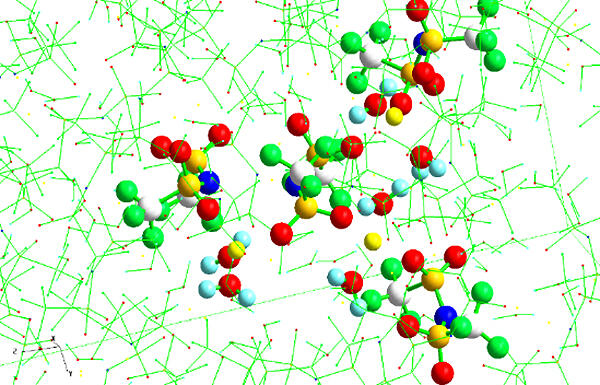A research group comprising Professor Yasuhiro Umebayashi of Niigata University, Graduate School of Science and Technology; Assistant Professor Hikari Watanabe of Tokyo University of Science, Faculty of Science and Technology; Professor Kenta Fujii of Yamaguchi University Graduate School of Sciences and Technology for Innovation; and Professor Toshiya Otomo of the High Energy Accelerator Research Organization (KEK) Institute of Materials Structure Science, in collaboration with research groups at Yamagata University and Yokohama National University, succeeded in clarifying the molecular-level liquid structure of an aqueous solution of a concentrated lithium salt, which is a potential new lithium ion battery (LIB) electrolyte.

Credit: Niigata Unversity
If water can be used in LIBs, the batteries would be safe and inexpensive, but it is extremely difficult to realize this because water reacts with lithium. Recently, a battery that uses three times the amount of lithium salt required by existing batteries, has a high energy density, and does not easily react with water has been reported; however, the functional principle is still elusive. According to Professor Umebayashi, "Theoretical simulations and similar experiments suggested that multiple lithium ions, anions, and water formed aggregates, although there was no evidence."
Since 2017, the research group has been engaged in clarifying the structures of concentrated lithium salt electrolytes; they combined the state analysis of lithium ions by Raman spectroscopy with experiments using neutrons and X-rays and theoretical simulations to clarify the molecular-level liquid structure of the aqueous solution of a concentrated lithium salt. In the aqueous solution of a concentrated lithium salt, the anions formed an aggregate in which two or more lithium ions were crosslinked; unlike dilute aqueous solutions, the hydrogen bond between adjacent water molecules was extremely weak. The film formed on the electrode is important for driving water-based LIBs, and an aggregate consisting of lithium ions and anions is suggested to be involved; notably, the formation of this aggregate was experimentally proved for the first time in this study.
As a next-generation storage battery, water-based LIBs are highly desirable, and several groups are competing globally to develop such batteries. The lithium ion structure in the aqueous solution of concentrated lithium salts has a significant influence on film formation, which holds the key to driving water-based LIBs. Using this result as a guideline, the research group will prepare an aqueous solution of a concentrated lithium salt that forms a better film and will apply it to storage batteries. Professor Umebayashi concluded, "By clarifying the structure of the electrolyte, it was determined that water and lithium did not react, allowing us to establish a guideline for fabricating batteries with a long life. If anions or additives that interfere in the reaction between water and lithium ions are identified, the batteries can be put to practical use."
■Aqueous solution of a concentrated lithium salt: An aqueous solution in which the amount of lithium dissolved is approximately three times that in the electrolytes used for existing lithium-ion batteries.
■Aggregate: Anions (TFSA ions) have the property of being able to bind to multiple lithium ions. A combination of multiple lithium ions and anions is termed an aggregate.
This article has been translated by JST with permission from The Science News Ltd.(https://sci-news.co.jp/). Unauthorized reproduction of the article and photographs is prohibited.




